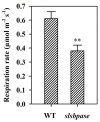Knockout of SlSBPASE Suppresses Carbon Assimilation and Alters Nitrogen Metabolism in Tomato Plants
- PMID: 30558146
- PMCID: PMC6320769
- DOI: 10.3390/ijms19124046
Knockout of SlSBPASE Suppresses Carbon Assimilation and Alters Nitrogen Metabolism in Tomato Plants
Abstract
Sedoheptulose-1,7-bisphosphatase (SBPase) is an enzyme in the Calvin⁻Benson cycle and has been documented to be important in carbon assimilation, growth and stress tolerance in plants. However, information on the impact of SBPase on carbon assimilation and nitrogen metabolism in tomato plants (Solanum lycopersicum) is rather limited. In the present study, we investigated the role of SBPase in carbon assimilation and nitrogen metabolism in tomato plants by knocking out SBPase gene SlSBPASE using clustered regularly interspaced short palindromic repeats (CRISPR)/CRISPR-associated protein 9 (Cas9) gene editing technology. Compared with wild-type plants, slsbpase mutant plants displayed severe growth retardation. Further analyses showed that knockout of SlSBPASE led to a substantial reduction in SBPase activity and as a consequence, ribulose-1,5-bisphosphate (RuBP) regeneration and carbon assimilation rate were dramatically inhibited in slsbpase mutant plants. It was further observed that much lower levels of sucrose and starch were accumulated in slsbpase mutant plants than their wild-type counterparts during the photoperiod. Intriguingly, mutation in SlSBPASE altered nitrogen metabolism as demonstrated by changes in levels of protein and amino acids and activities of nitrogen metabolic enzymes. Collectively, our data suggest that SlSBPASE is required for optimal growth, carbon assimilation and nitrogen metabolism in tomato plants.
Keywords: CRISPR/Cas9; SBPase; carbon assimilation; nitrogen metabolism; tomato.
Conflict of interest statement
The authors declare no conflict of interest.
Figures







Similar articles
-
Sedoheptulose-1,7-Bisphosphatase is Involved in Methyl Jasmonate- and Dark-Induced Leaf Senescence in Tomato Plants.Int J Mol Sci. 2018 Nov 20;19(11):3673. doi: 10.3390/ijms19113673. Int J Mol Sci. 2018. PMID: 30463360 Free PMC article.
-
Mutation of SlSBPASE Aggravates Chilling-Induced Oxidative Stress by Impairing Glutathione Biosynthesis and Suppressing Ascorbate-Glutathione Recycling in Tomato Plants.Front Plant Sci. 2020 Dec 22;11:565701. doi: 10.3389/fpls.2020.565701. eCollection 2020. Front Plant Sci. 2020. PMID: 33414794 Free PMC article.
-
Changes in SBPase activity influence photosynthetic capacity, growth, and tolerance to chilling stress in transgenic tomato plants.Sci Rep. 2016 Sep 2;6:32741. doi: 10.1038/srep32741. Sci Rep. 2016. PMID: 27586456 Free PMC article.
-
A status-quo review on CRISPR-Cas9 gene editing applications in tomato.Int J Biol Macromol. 2021 Nov 1;190:120-129. doi: 10.1016/j.ijbiomac.2021.08.169. Epub 2021 Aug 30. Int J Biol Macromol. 2021. PMID: 34474054 Review.
-
Integration of sulfate assimilation with carbon and nitrogen metabolism in transition from C3 to C4 photosynthesis.J Exp Bot. 2019 Aug 19;70(16):4211-4221. doi: 10.1093/jxb/erz250. J Exp Bot. 2019. PMID: 31124557 Free PMC article. Review.
Cited by
-
Genome Editing Targets for Improving Nutrient Use Efficiency and Nutrient Stress Adaptation.Front Genet. 2022 Jun 14;13:900897. doi: 10.3389/fgene.2022.900897. eCollection 2022. Front Genet. 2022. PMID: 35774509 Free PMC article. Review.
-
CRISPR/Cas genome editing in tomato improvement: Advances and applications.Front Plant Sci. 2023 Feb 23;14:1121209. doi: 10.3389/fpls.2023.1121209. eCollection 2023. Front Plant Sci. 2023. PMID: 36909403 Free PMC article. Review.
-
Melatonin Mitigates Chilling-Induced Oxidative Stress and Photosynthesis Inhibition in Tomato Plants.Antioxidants (Basel). 2020 Mar 6;9(3):218. doi: 10.3390/antiox9030218. Antioxidants (Basel). 2020. PMID: 32155702 Free PMC article.
-
CRISPR-Cas9 mediated enhancement of abiotic stress resilience in tomato: a comprehensive review of target genes.Mol Biol Rep. 2025 Jun 3;52(1):538. doi: 10.1007/s11033-025-10634-9. Mol Biol Rep. 2025. PMID: 40459840 Review.
-
Mitochondrial transfer between BMSCs and Müller promotes mitochondrial fusion and suppresses gliosis in degenerative retina.iScience. 2024 Jun 20;27(7):110309. doi: 10.1016/j.isci.2024.110309. eCollection 2024 Jul 19. iScience. 2024. PMID: 39055937 Free PMC article.
References
-
- Geiger D.R., Servaites J.C. Diurnal regulation of photosynthetic carbon metabolism in C3 plants. Annu. Rev. Plant Biol. 1994;45:235–256. doi: 10.1146/annurev.pp.45.060194.001315. - DOI
-
- Raines C.A., Lloyd J.C., Dyer T.A. New insights into the structure and function of sedoheptulose-1,7-bisphosphatase; an important but neglected Calvin cycle enzyme. J. Exp. Bot. 1999;50:1–8.
-
- Laing W.A., Stitt M., Heldt H.W. Control of CO2 fixation. Changes in the activity of ribulosephosphate kinase and fructose- and sedoheptulose-bisphosphatase in chloroplasts. BBA Bioenerg. 1981;637:348–359. doi: 10.1016/0005-2728(81)90174-2. - DOI
-
- Woodrow I.E., Murphy D.J., Latzko E. Regulation of stromal sedoheptulose 1,7-bisphosphatase activity by pH and Mg2+ concentration. J. Biol. Chem. 1984;259:3791–3795. - PubMed
-
- Breazeale V.D., Buchanan B.B., Wolosiuk R.A. Chloroplast sedoheptulose-1,7-bisphosphatase: Evidence for regulation by the ferredoxin/thioredoxin system. Z. Naturforsch. C. 1978;33:521–528. doi: 10.1515/znc-1978-7-812. - DOI
MeSH terms
Substances
Grants and funding
LinkOut - more resources
Full Text Sources
Other Literature Sources

